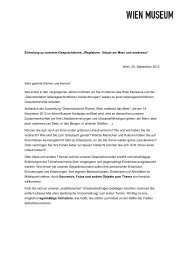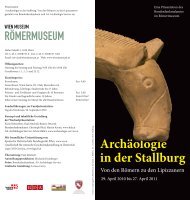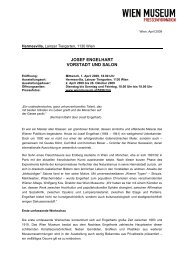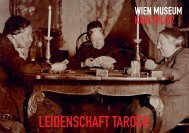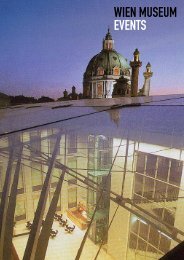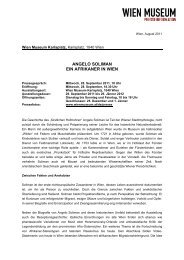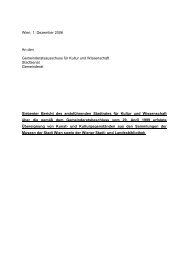the prophet the world of karl wilhelm diefenbach - Wien Museum
the prophet the world of karl wilhelm diefenbach - Wien Museum
the prophet the world of karl wilhelm diefenbach - Wien Museum
Create successful ePaper yourself
Turn your PDF publications into a flip-book with our unique Google optimized e-Paper software.
Hermesvilla, Lainzer Tiergarten, 1130 Vienna<br />
Vienna, February 2011<br />
THE PROPHET<br />
THE WORLD OF KARL WILHELM DIEFENBACH<br />
An exhibition by <strong>Museum</strong> Villa Stuck, Munich, in cooperation with <strong>Wien</strong> <strong>Museum</strong><br />
Opening Event: Wednesday, 6 April 2011, 6.30 p.m.<br />
Venue: Hermesvilla, Lainzer Tiergarten, 1130 Vienna<br />
Duration: 7 April 2011 to 26 October 2011<br />
Opening hours: Tuesday to Sunday, including public holidays,<br />
from 10 a.m. to 6 p.m.<br />
Press photos: www.wienmuseum.at/de/presse<br />
“Let me die ra<strong>the</strong>r than deny my ideals!”<br />
Karl Wilhelm Diefenbach (1851–1913) was an eccentric artist and outsider who first caused a<br />
sensation in Germany in <strong>the</strong> 1880s: as a barefoot vegetarian in a cowl, as a "life reformer" advocating<br />
nudism, as a self-styled <strong>prophet</strong> who preached peace, and not least as a painter <strong>of</strong> monumental<br />
pictures in late symbolist style, which he used to advertise his ideas.<br />
In 1892, Diefenbach and his children moved from Munich to Vienna, where he exhibited his paintings<br />
– and was ridiculed as a "kohlrabi apostle", just as he had been before in Germany. Although he<br />
suffered an existential crisis following a conflict with <strong>the</strong> artists' association <strong>Wien</strong>er Kunstverein, he<br />
decided to stay in <strong>the</strong> city, founding <strong>the</strong> highly controversial "Himmelh<strong>of</strong>" commune where he ruled in<br />
authoritarian style. His restless life eventually led Diefenbach to <strong>the</strong> island <strong>of</strong> Capri, <strong>the</strong>n a popular<br />
spot with artists and Bohemians. After his death <strong>the</strong>re in 1913, he soon faded into oblivion.<br />
Rare items from private collections<br />
The exhibition now on show at Hermesvilla has been curated by Diefenbach expert Claudia Wagner<br />
and was a great success at Villa Stuck in Munich, where it first went on display under <strong>the</strong> title Karl<br />
Wilhelm Diefenbach (1851–1913). „Lieber sterben, als meine Ideale verleugnen!“ (“Let me die ra<strong>the</strong>r<br />
than deny my ideals!”). It includes about 30 paintings by Diefenbach, most <strong>of</strong> which have never been<br />
displayed in public before; many <strong>of</strong> <strong>the</strong>m are on loan from private collections around <strong>the</strong> <strong>world</strong>. Also on<br />
show are <strong>the</strong> most important parts <strong>of</strong> his magnum opus, <strong>the</strong> 68-metre frieze Per aspera ad astra,<br />
which Diefenbach painted in Vienna. Some space has been reserved for Diefenbach's disciples,<br />
among <strong>the</strong>m <strong>the</strong> well-known artist František Kupka, <strong>the</strong> "revolutionary" Gusto Gräser and Hugo<br />
Höppener, alias Fidus, a later sympathizer with Nazi ideology. Many photographs and private<br />
documents <strong>of</strong>fer insights into <strong>the</strong> personal lifestyle and environment <strong>of</strong> Diefenbach, a key figure <strong>of</strong> <strong>the</strong><br />
"life reform" movement in Europe around 1900.
“The exhibition <strong>of</strong>fers a remarkable juxtaposition <strong>of</strong> micro and macro perspectives,” says Wolfgang<br />
Kos, Director <strong>of</strong> <strong>Wien</strong> <strong>Museum</strong>. “We get a close-up, monographic view <strong>of</strong> Diefenbach's life and work<br />
with its inherent conflicts and contradictions, but also a sweeping panorama <strong>of</strong> all <strong>the</strong> novel doctrines<br />
<strong>of</strong> salvation that were so trendy around 1900 and gave mainstream society ample opportunity for<br />
gossip and outrage. This is why we decided on <strong>the</strong> subtitle ‘The <strong>world</strong> <strong>of</strong> Karl Wilhelm Diefenbach’ for<br />
<strong>the</strong> exhibition.” Commenting on <strong>the</strong> exhibition venue, Kos points out: “Hermesvilla is located on <strong>the</strong><br />
fringes <strong>of</strong> <strong>the</strong> Vienna Woods. From here, a 20-minute walk along a footpath will get you to Himmelh<strong>of</strong>,<br />
where Diefenbach’s group <strong>of</strong> social dropouts took up residence. Originally built as a refuge where<br />
Empress Elisabeth could drift <strong>of</strong>f into a symbol-laden dream <strong>world</strong>, Hermesvilla provides a fitting<br />
genius loci for <strong>the</strong> Diefenbach exhibition.”<br />
Milestones in <strong>the</strong> life <strong>of</strong> an outsider<br />
Diefenbach was born in Hadamar, a small town in <strong>the</strong> German state <strong>of</strong> Hesse, where he grew up in a<br />
provincial Catholic household <strong>of</strong> moderate means. In 1872 he began to study painting at <strong>the</strong> Munich<br />
Academy <strong>of</strong> Fine Arts. After a severe bout <strong>of</strong> typhoid fever, Diefenbach renounced <strong>the</strong> consumption <strong>of</strong><br />
tobacco, alcohol and “lumps <strong>of</strong> animal flesh”. He engaged in free love relationships early on and left<br />
<strong>the</strong> Catholic Church (an “institute <strong>of</strong> satan”) in 1881. The following year, he married Magdalena<br />
Atzinger, with whom he already had a son; two more children were to follow. Deserting his bride on<br />
<strong>the</strong>ir wedding night, Diefenbach walked up <strong>the</strong> Hohenpeißenberg mountain in Upper Bavaria, where<br />
he experienced a spiritual awakening while watching <strong>the</strong> morning sunrise. This inspired him to pen <strong>the</strong><br />
ode Sonnen-Aufgang (“Sunrise”), a kind <strong>of</strong> literary credo in which he called upon man to “know<br />
yourself [...] God is within YOU [...] Recognise, humanity, your mo<strong>the</strong>r – NATURE”.<br />
From <strong>the</strong>n on, Diefenbach let his hair grow long, wandered <strong>the</strong> streets <strong>of</strong> Munich’s Bohemian<br />
neighbourhood Schwabing in sandals and a cowl and gave highly controversial lectures on how to live<br />
in harmony with nature. He founded his first commune in <strong>the</strong> Höllriegelskreuth quarry in 1885, where<br />
<strong>the</strong> Art Nouveau painter Hugo Höppener, alias Fidus, was one <strong>of</strong> his closest companions. Höppener<br />
also organised <strong>the</strong> first Diefenbach exhibition in Munich, but <strong>the</strong> latter’s authoritarian personality soon<br />
gave rise to serious quarrels between <strong>the</strong> two friends. Diefenbach also came under attack from<br />
government authorities on charges <strong>of</strong> “neglect <strong>of</strong> his children”, and after members <strong>of</strong> <strong>the</strong> commune<br />
were observed to be sunbathing in <strong>the</strong> nude, he had to defend himself in <strong>the</strong> first “nudist trial” in<br />
German history. On top <strong>of</strong> <strong>the</strong>se problems, his financial situation was becoming more and more<br />
untenable.<br />
A fiasco in Vienna<br />
Diefenbach <strong>the</strong>refore accepted an invitation from <strong>the</strong> Österreichischer Kunstverein, an Austrian artists’<br />
association that wanted him to supply “sensational paintings as quickly as possible” for an exhibition in<br />
Vienna – a financial rescue operation for <strong>the</strong> Kunstverein, which was on <strong>the</strong> verge <strong>of</strong> bankruptcy. The<br />
eccentric artist painted eleven large murals which, although not quite <strong>the</strong> erotic-voyeuristic stuff <strong>the</strong><br />
organisers had hoped for, managed to attract 78,000 visitors within five months. Never<strong>the</strong>less, <strong>the</strong><br />
exhibition culminated in a fiasco for Diefenbach, as Kunstverein board members embezzled money<br />
from a loan which Kunstverein had taken out using his paintings as collateral. Eventually, <strong>the</strong> ten<br />
biggest paintings were sold at auction, but Diefenbach came away empty-handed and was forced to<br />
register with <strong>the</strong> authorities as a homeless person <strong>of</strong> no means.
After a hiking tour through <strong>the</strong> Alps and a brief “flight” to Egypt, Diefenbach founded <strong>the</strong> rural<br />
commune “Himmelh<strong>of</strong>” in Ober St. Veit, on <strong>the</strong> outskirts <strong>of</strong> Vienna, in 1897. With a mixed population <strong>of</strong><br />
eccentrics and proletarians, numbering up to 24 in its heyday, <strong>the</strong> commune became a forerunner <strong>of</strong><br />
innumerable reform-minded “alternative” living and working communities in <strong>the</strong> 20 th century.<br />
Diefenbach again ruled <strong>the</strong> commune in exceedingly authoritarian style, with a system <strong>of</strong> iron rules<br />
and regulations; among o<strong>the</strong>r things, all members had to submit journals <strong>of</strong> <strong>the</strong>ir daily activities to <strong>the</strong><br />
“Master”. This resulted in tension and conflicts within <strong>the</strong> group, and members repeatedly dropped out<br />
<strong>of</strong> <strong>the</strong> commune. It was in this period that Diefenbach painted his monumental 34-panel frieze Per<br />
aspera ad astra. Heralded as <strong>the</strong> artist’s “painted manifesto”, <strong>the</strong> frieze was first put on public display<br />
in 1898. However, <strong>the</strong> provocative lifestyle <strong>of</strong> <strong>the</strong> Himmelh<strong>of</strong> commune triggered an avalanche <strong>of</strong><br />
invective in <strong>the</strong> press. Under <strong>the</strong> headline “The master <strong>of</strong> doing nothing yet living none<strong>the</strong>less”, <strong>the</strong><br />
daily Neuigkeits-Weltblatt fulminated “against <strong>the</strong> ‘immoral’ activities <strong>of</strong> <strong>the</strong> company <strong>of</strong> ‘scroungers’<br />
and ‘fools’ at ‘Himmelh<strong>of</strong>’, which constitute a ‘public danger’ and abuse <strong>the</strong> charitable nature <strong>of</strong> <strong>the</strong><br />
Viennese, engaging in ‘whimsical ... charlatanry,’ in ‘a life <strong>of</strong> shameless idleness’.”<br />
When <strong>the</strong> commune went bankrupt in 1899 and was dissolved as a result, Diefenbach intended to go<br />
on a journey to <strong>the</strong> orient; after a brief sojourn in Trieste, however, he ended up on <strong>the</strong> island <strong>of</strong> Capri,<br />
where he spent his last years without achieving a breakthrough as an artist. He tried to get celebrities<br />
such as industrialist Alfred Krupp, physician Axel Mun<strong>the</strong> and writer Maxim Gorki interested in his<br />
paintings, but <strong>the</strong>se attempts failed.<br />
Diefenbach and <strong>the</strong> “life reform” movement around 1900<br />
Diefenbach is regarded today as an influential forerunner <strong>of</strong> reform movements around 1900, whose<br />
protagonists in Vienna included figures such as writer Peter Altenberg and Florian Berndl, <strong>the</strong> “fa<strong>the</strong>r<br />
<strong>of</strong> <strong>the</strong> [public bathing institution] Gänsehäufel”. Diefenbach was not <strong>the</strong> only reformer who engaged in<br />
“free love” in his communes and walked around in shapeless garments in practical application <strong>of</strong> his<br />
teachings about liberation from physical restraints. However, his ra<strong>the</strong>r harmless naked sunbathing<br />
was enough to land him in <strong>the</strong> dock in 1888 in <strong>the</strong> first “nudist trial” in German history. With his attacks<br />
against <strong>the</strong> Church and rejection <strong>of</strong> <strong>the</strong> notion <strong>of</strong> a Christian redeemer-god, he shared <strong>the</strong> ideas <strong>of</strong> an<br />
influential contemporary: philosopher Friedrich Nietzsche, author <strong>of</strong> Thus Spake Zarathustra.<br />
With respect to nutrition and personal lifestyle, <strong>the</strong> rejection <strong>of</strong> tobacco, alcohol, c<strong>of</strong>fee and meat,<br />
combined with <strong>the</strong> practice <strong>of</strong> nudist sunbathing, were an amalgamation <strong>of</strong> various strands <strong>of</strong><br />
vegetarianism. According to <strong>the</strong> teachings <strong>of</strong> naturopathy, this lifestyle would heal all ills <strong>of</strong> mind and<br />
body. Later on, arguments for vegetarianism were increasingly based on ethical considerations,<br />
focusing on respect for all living beings. At <strong>the</strong> same time, vegetarianism began to tend towards a<br />
more generalised pacifism, aiming at a state <strong>of</strong> conflict-free coexistence <strong>of</strong> all humankind, not just <strong>of</strong><br />
man and beast: vegetarianism would help prevent war, it was argued. The most prominent thinkers <strong>of</strong><br />
this period were Magnus Schwantje, who founded <strong>the</strong> “Bund für radikale Ethik” (“Society for radical<br />
ethics”) and Eduard Baltzer <strong>of</strong> <strong>the</strong> “Deutscher Verein für natürliche Lebensweise“ (“German<br />
Association for a natural lifestyle”), both <strong>of</strong> whom engaged in frequent exchanges with Diefenbach, as<br />
did peace activist Bertha von Suttner.
Hermesvilla, Lainzer Tiergarten, 1130 Vienna<br />
Vienna, February 2011<br />
THE PROPHET<br />
THE WORLD OF KARL WILHELM DIEFENBACH<br />
An exhibition by <strong>Museum</strong> Villa Stuck, Munich, in cooperation with <strong>Wien</strong> <strong>Museum</strong><br />
Opening Event: Wednesday, 6 April 2011, 6.30 p.m.<br />
Venue: Hermesvilla, Lainzer Tiergarten, 1130 Vienna<br />
Duration: 7 April 2011 to 26 October 2011<br />
Opening hours: Tuesdays to Sundays, including public holidays, 10 a.m. to 6 p.m.<br />
Press photos: www.wienmuseum.at/de/presse<br />
Admission fees: Adults € 5, concessions € 3.50 (senior citizens, Vienna Card and Ö1<br />
Club card holders, persons with disabilities, groups <strong>of</strong> ten and more)<br />
or € 2.50 (apprentices and students up to 27 years <strong>of</strong> age).<br />
Admission is free for schoolchildren and students under 19.<br />
Free admission for all visitors on <strong>the</strong> first Sunday <strong>of</strong> each month!<br />
Introductory tour: Sundays and public holidays, 2 p.m.<br />
To book tours for groups, please call: (+43 1) 505 87 47- 85180, or<br />
mail to: service@wienmuseum.at<br />
Visitor information: Phone (+43 1) 505 87 47-0, www.wienmuseum.at<br />
e-mail: service@wienmuseum.at<br />
Curator: Claudia Wagner<br />
<strong>Wien</strong> <strong>Museum</strong> curators: Michaela Lindinger, Monika Sommer<br />
Exhibition production: Bärbl Schrems<br />
Exhibition design: Dzengel+Osten<br />
Accompanying book: Karl Wilhelm Diefenbach (1851–1913). Lieber sterben, als meine<br />
Ideale verleugnen! Michael Buhrs and Claudia Wagner (eds.). Edition<br />
Minerva, 240 pages / € 25.<br />
Main sponsor <strong>of</strong> <strong>Wien</strong> <strong>Museum</strong>: <strong>Wien</strong>er Stadtwerke<br />
Press contact: Peter Stuiber, <strong>Wien</strong> <strong>Museum</strong><br />
Phone (+43 1) 505 87 47 - 84019, Fax (+43 1) 505 87 47 - 7201<br />
e-mail: peter.stuiber@wienmuseum.at<br />
Barbara Wieser, <strong>Wien</strong> <strong>Museum</strong><br />
Phone (+43 1) 505 87 47 - 84068, Fax (+43 1) 505 87 47 - 7201<br />
e-mail: barbara.wieser@wienmuseum.at<br />
www.wienmuseum.at



